My wanderer mind doesn’t allow me to sit at home on weekends. Saturday was spent in some household things and evening made me ‘outing-sick’. Yes, ‘no-outing’ syndrome can be as serious as any other syndrome… no kidding friends!!! 🙂
Question was ‘where?’- An immediate answer was “Vadhu – Tulapur”. I am always obsessed by bravery of our great second Chatrapati i.e. Sambhaji Maharaj and so these places mean so much as far as history is concerned.
I made a plan to visit Vadhu, Tulapur and Phulgaon. I got up early and started at sharp 7:00. Rising sun added to the beauty of the morning. I took up Nagar highway.
Wagholi was my first hault. We can see a Shri Wagheshwar (or Wyaghreshwar) temple (श्री व्याघ्रेश्वर) surrounded by small lake on left side of highway. Just near the temple, there is black stone moument which is ‘samadhi’ of maratha sardar called ‘Pilajirao Jadhav’. He fought and won against Nizam and worked closely with Bajirao Peshwa-I. Jadhav belonged to Wagholi and his heirs built this samadhi. ‘Jadhavgad’, now turned into ‘Kamath Resort’ near Saswad belonged to these Jadhavs. Then I headed towards Tulapur.
To reach Tulapur:
1. Take Ahmednagar Highway (SH-60) and travel till ‘Lonikand’ village.
2. Travel some more, you will see board written with Sambhaji Maharaj’s pic and take left turn to go to Tulapur village.
3. Tulapur is exactly 6 kms from here. Once you take turn, you can see MSEB power station towers. Travel on tar road to reach Tulapur. You can ask villagers for ‘Sangameshwar’ temple or simply ‘Sangam’.
4. Tulapur Sangam is on right side. There is ample parking space (yes, even for 4-wheelers).
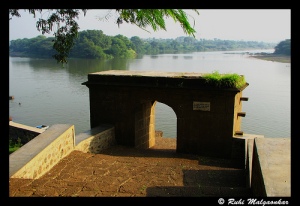 Tulapur (तुळापूर) was earlier called as ‘Naagargaon’ (नागरगाव). Adilshahi Vajir ‘Murar Jagdev’ was advised by his guru to rebuild the destructed temple of ‘Sangameshwar’ which he did. Later on, Murar Jagdev wished to donate gold as much as weight of elephant. Shahaji Maharaj gave him solution of weighing the elephant in the boat and marking the depth of boat. The boat was then refilled with stone and they were weighed and same amount of gold was donated. With this sheer intelligence of Shahaji Maharaj, Murar Jagdev could literally weigh the gold as much as an elephant. ‘Naagargaon’ was then renamed as ‘Tulapur’ i.e. ‘Weighing town’.
Tulapur (तुळापूर) was earlier called as ‘Naagargaon’ (नागरगाव). Adilshahi Vajir ‘Murar Jagdev’ was advised by his guru to rebuild the destructed temple of ‘Sangameshwar’ which he did. Later on, Murar Jagdev wished to donate gold as much as weight of elephant. Shahaji Maharaj gave him solution of weighing the elephant in the boat and marking the depth of boat. The boat was then refilled with stone and they were weighed and same amount of gold was donated. With this sheer intelligence of Shahaji Maharaj, Murar Jagdev could literally weigh the gold as much as an elephant. ‘Naagargaon’ was then renamed as ‘Tulapur’ i.e. ‘Weighing town’.
Tulapur itself must have been unaware then, of what it has to see in 3rd generation of Shahaji Maharaj. Young Chatrapati Sambhaji Maharaj (age 32) was caught in Sangameshwar, Konkan (Ratnagiri). One of his brother-in-laws, Ganoji Shirke deceived the Marathas and helped Aurangzeb’s commander, Mukarrab Khan to attack Sangameshwar when Sambhaji was in the garden, resolving some issues and was about to leave the town. With strong army of 20,000 people, Julfikarkhan moved towards Karad and then Baramati and finally to Bahadurgad near Bhima river.
Ganoji’s hunger for Maratha land in the form of watan led to his enmity with Sambhaji. Sambhaji like his father- Shivaji Maharaj had abolished the custom of giving away watans, as this led to the people’s suffering, from the hands of the watandar and there were chances of the watandars assuming kingship or taking possession of their watans.
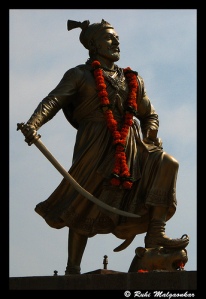 Sambhaji was tortured and executed in most cruelest way to death. He was asked to surrender his kingdom to Aurangzeb and convert to Islam religion. Sambhaji refused to convert and instead sang praises of Mahadev (Lord Shiva). Aurangzeb ordered his men to torture Sambhaji and his friend Kavi Kalash to death. Each cruel punishment was given to kavi Kalash prior to Sambhaji as if it was a rehearsal.
Sambhaji was tortured and executed in most cruelest way to death. He was asked to surrender his kingdom to Aurangzeb and convert to Islam religion. Sambhaji refused to convert and instead sang praises of Mahadev (Lord Shiva). Aurangzeb ordered his men to torture Sambhaji and his friend Kavi Kalash to death. Each cruel punishment was given to kavi Kalash prior to Sambhaji as if it was a rehearsal.
They both were dressed as clowns, with their body tied in heavy iron chains and huge wooden logs on their neck and shoulders. They were tied on camel and given a ride in village. All men and women from Aurangzeb’s troop came to see this captured Maratha warrior. People threw stones and dung at them. Their eyes were burned off with hot iron bars and tongue was plucked. They were beaten up till their wounds bleed and then were given baths of salt-water. Their skin was peeled off with ‘Wagh nakhe‘. Their legs and hands were cut off and lastly the head. Sambhaji’s body was cut into pieces and was thrown away for crows, vultures and dogs to eat. On 11 March 1689, Sambhaji was finally killed at Sangameshwar at Tulapur, near Pune. He sacrificed his life at age of 32 for ‘Dharma‘ i.e. Religion which is why he is called ‘Dharmaveer Sambhaji’.
It was the worst death anyone could get. It is truly said there was/is no king as great as Sambhaji Maharaj. No matter whether few historian portait him as spoiled brat or non-managed king or characterless or whatever, there is no actual historical proofs or evidences for their statements.
I read “Chhavaa” when i was very young and it moved me. ‘Sambhaji’, son of great Shivaji Maharaj, lost his mother at age of 2, brought up my his grand mother and the lady who made Shivaji i.e. Jijabai, at age of 10 he had mastery in 8 different languages including Sanskrit and Urdu, a soft-hearted prince, a sankrit poet, a passionate writer, a great warrior, most eligible Yuvraj, a heir who suffered from politics at home due to his step-mother Soyrabai, estranged son of Shivaji due to mis-communication and misunderstandings, our second chatrapati, one who fought with Aurangzeb and defended maratha kingdom for 12 years after Shivaji’s death without losing a single battle and the list can be endless. His multi-facet persona fascinates me like anything. I become very emotional and my eyes turn watery everytime I think of Sambhaji. Soyrabai’s own brother Hambirrao Mohite stood by Sambhaji Maharaj as he knew his sister was wrong and Sambhaji was well-deserved would-be king on Maratha throne.
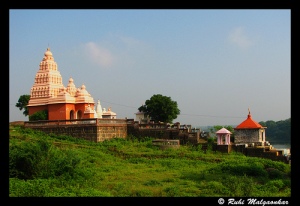 I parked my vehicle outside the small garden at Sangameshwar Temple (संगमेश्वर). There is Sambhaji’s Statue and smarak just outside the Sangameshwar temple. I visited temple and smarak; bowed in front of Lord Shiva(temple) and at Sambhaji’s statue (who I think was indeed a personified form of lord Shiva).
I parked my vehicle outside the small garden at Sangameshwar Temple (संगमेश्वर). There is Sambhaji’s Statue and smarak just outside the Sangameshwar temple. I visited temple and smarak; bowed in front of Lord Shiva(temple) and at Sambhaji’s statue (who I think was indeed a personified form of lord Shiva).
I went to Sangam ghat where 3 rivers Bhima, Bhama and Indrayani unite. There are beautiful Shri Ballaleshwar (श्री बल्लाळेश्वर) and old Ganapati temples just near the ghat. I clicked some snaps. After spending enough time, I continued my journey to Vadhu.
Phulgaon (फुलगाव):
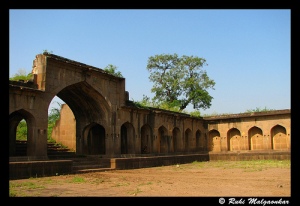 I had planned a new place in the midway i.e. Phulgaon. Phulgaon is on the road back from Tulapur to Nagar Highway. There is ‘Shrutisagar Ashram’ in Phulgaon which I visited last time. This time, I wished to see something different i.e. ‘Phulgaon ghat’. River Bhima takes a semi-circular curve at Phulgaon and a stone built wall at ghat is worth a dekko. Water was serene and it was peaceful. I climbed up the wall and sat for some time watching Pied Kingfishers, White-throated Kingfisher and Swallows. There was Peshwas palace here but now there are only ruins left.
I had planned a new place in the midway i.e. Phulgaon. Phulgaon is on the road back from Tulapur to Nagar Highway. There is ‘Shrutisagar Ashram’ in Phulgaon which I visited last time. This time, I wished to see something different i.e. ‘Phulgaon ghat’. River Bhima takes a semi-circular curve at Phulgaon and a stone built wall at ghat is worth a dekko. Water was serene and it was peaceful. I climbed up the wall and sat for some time watching Pied Kingfishers, White-throated Kingfisher and Swallows. There was Peshwas palace here but now there are only ruins left.
I started for Vadhu from Phulgaon. There is road from Tulapur from Vadhu which is in not good condition. Better is to come back to highway and go to Vadhu via Bhima-Koregaon village.
To reach Vadhu:
1. Take Nagar Highway.
2. Travel to village ‘Lonikand’.
3. Cross the Toll plaza and immediate village is ‘Bhima-Koregaon’. Toll is Rs.31/- for single journey and Rs.57/- for return.
4. Take left turn which goes to Vadhu.
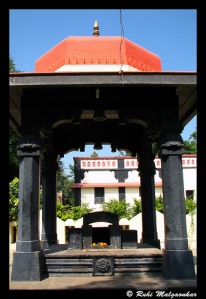 Vadhu (वढू) is the place where actual last rites (funeral) of Sambhaji Maharaj was carried out. Few brave maratha sardars from ‘Patil’ family collected the body pieces of Sambhaji and sewed them together and performed final rites at this place. They were given name ‘Shivale Patil’ for an act of this bravery. ‘Shivale’ literally means ‘Sewing’ in Marathi (मराठी: शिवले) .
Vadhu (वढू) is the place where actual last rites (funeral) of Sambhaji Maharaj was carried out. Few brave maratha sardars from ‘Patil’ family collected the body pieces of Sambhaji and sewed them together and performed final rites at this place. They were given name ‘Shivale Patil’ for an act of this bravery. ‘Shivale’ literally means ‘Sewing’ in Marathi (मराठी: शिवले) .
After few years, Sambhaji’s son Chatrapati Shahu along with his mother Yesubai came to Vadhu and gave donation to conserve this place. The statue reflecting Sambhaji’s personality is simply superb. There are Sambhaji’s and Kavi Kalash’s samadhis. I paid my tribute and started my returned journey.
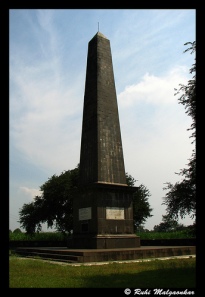 On the way back, a war monument at Bhima-Koregaon toll plaza caught my attention. I parked my vehicle and went inside. This ‘Ran-sthambh’ or war monument is erected in 1822, in the memory of soldiers who lost their lives in last British-Maratha war. Most of the soldiers where Hindu who fought from the side of British army. The soldiers’ names are carved in marble at bottom of this stone. Every 1st January ‘Mahar Regiment’ pays tribute to this war monument.
On the way back, a war monument at Bhima-Koregaon toll plaza caught my attention. I parked my vehicle and went inside. This ‘Ran-sthambh’ or war monument is erected in 1822, in the memory of soldiers who lost their lives in last British-Maratha war. Most of the soldiers where Hindu who fought from the side of British army. The soldiers’ names are carved in marble at bottom of this stone. Every 1st January ‘Mahar Regiment’ pays tribute to this war monument.
I started my return journey and reached home in the afternoon. I had been to Vadhu-Tulapur some 4 odd years ago and still can go there for n-times. Chatrapati Sambhaji Maharaj definitely deserves our respect in a form of such tribute visits!!!
For more snaps, visit – http://www.flickr.com/photos/ruhiclicks/sets/72157622293200575/



